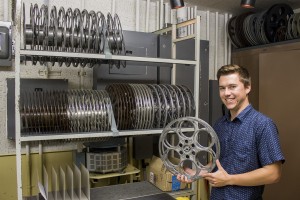Daniel Apodaca’s first brush with filmmaking involved filming his friends jumping over tennis nets and gliding down handrails on their skateboards.
Growing up as a teenager in East Los Angeles, the third-year film student watched online tutorials to learn how to shoot and edit his skate videos. He later worked as a cameraman and visual effects artist, before beginning to explore his interest in professional cinematography in May 2016.
He is working on an independent short film called”Kingdom of Bliss” as the director of photography, also known as the cinematographer. He hopes to pursue a career in film because of its collaborative environment.
“I always found storytelling through camera very intriguing,” he said. “Just making beautiful images.”
[Related: The Bruin behind viral ball-pit dress worn at the Grammys]
Before transferring to UCLA, Apodaca worked as a freelance videographer for events like weddings and shot comedic shorts for YouTubers such as the Fung Brothers. He spent two years as a visual effects artist on 10 feature films, including “99 Homes,” starring Andrew Garfield, where he gained knowledge of how a production team makes a feature film come to life, he said.
As a videographer for smaller online projects, he often carried out the work of an entire film crew by himself, which caused his work to suffer as he was spreading himself too thin, he said. By going back to school at UCLA, he found students to partner with to create more meaningful film narratives as a cinematographer.
“It takes a lot of hands to make good cinematography happen,” he said. “It’s not something you can do by yourself.”
Apodaca enjoys the collaborative aspect of filmmaking, working with directors and crew members to develop a story through his role as a cinematographer, he said. The director, who is in charge of the story and script, will form an idea, and Apodaca is responsible for establishing the technical and visual limitations on executing the director’s idea. He instructs how the scenes are shot.

The film “Kingdom of Bliss” depicts the struggle of a heroin addict who is unable to escape her destructive lifestyle and toxic partner. The period of preproduction began in January and involved meeting with the director to discuss how to portray themes of loneliness and withdrawal through the camera shots.
“How can the image actually benefit the story?” Apodaca said.
For the film, Apodaca plans on using wide shots of small, lone characters against expansive backdrops to evoke a sense of isolation. Two characters will stand on the seventh floor of the Broad Art Center, shot from the point of view of someone on the ground.
The use of zoomed-out shots is meant to create a feeling of physical and emotional distance, he said.
[Read more: Student animator brings stopped world into motion for new music video]
Cinematography graduate student Gionatan Tecle works with Apodaca as a gaffer, shaping the light for the cinematographer. The director and cinematographer meet to determine how to achieve a certain visual quality, in this case a grittier texture, which Tecle then executes through the use of yellowish filters or gels.
“Most directors are visual storytellers, but they need a director of photography to help them create that visual sense,” he said.
In addition to camera angles and lighting, Apodaca also addresses the more logistical aspects of filming.
Before shooting, the director and assistant director develop a shot list, which outlines a schedule for each day and describes each scene. Apodaca reviews the list to determine whether the shots are feasible depending on the type of cameras used or the time of day they are filming.
Malachi Whitten, a third-year film student and the director of “Kingdom of Bliss,” envisioned a scene in which the main character wakes up in her bathroom and the camera floats from her point of view to an outside perspective looking down at her. The idea was ultimately dropped in favor of subtler camera movements due to the small space and lack of proper equipment.
Whitten and Apodaca discuss elements such as camera angles, the subject of the shot and the length of each scene. The process makes production run smoothly, Whitten said.
“He’s like my right-hand man,” Whitten said.
In a collaborative setting, Apodaca focuses on how to visually depict concepts effectively, turning his early passion for creating videos into a position in the film industry.
“I was running around with a bunch of hooligans, doing cool tricks and putting them on the internet,” he said. “I found that I just enjoyed using cameras.”
